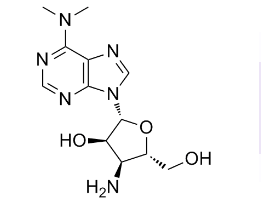All AbMole products are for research use only, cannot be used for human consumption.

Puromycin aminonucleoside (PAN), which is an analogue of puromycin antibiotic, has been largely adopted to experimentally induce MCD in rodents (with a single high dose) or FSGS (by repeated doses for over a longer period).
In vitro: Puromycin aminonucleoside (30 μg/mL) markedly increases p53 protein levels in podocytes. Puromycin aminonucleoside-induced podocyte apoptosis is p53 dependent and supports the notion that dexamethasone exerts an antiapoptotic effect on cells that are exposed to Puromycin aminonucleoside through the downregulation of p53. Puromycin aminonucleoside induces podocyte apoptosis in a time-dependent manner. The IC50 values for PMAT-expressing and vector-transfected cells are 48.9 and 122.1 μM, respectively, suggesting expression of PMAT-enhanced cell sensitivity to Puromycin aminonucleoside. Puromycin aminonucleoside (250 μM) is toxic to both PMAT-expressing and vector-transfected cells. Puromycin aminonucleoside uptake in PMAT-expressing cells is fourfold higher at pH 6.6 than that at pH 7.4.
In vivo: The number of podocytes per glomerulus is 95.5±17.6 in the control rats, 90.7 on Day 4 in Puromycin aminonucleoside (8 mg/100 g, i.v.)-treated nephrosis rats. The amount of nephrin per glomerulus in control rats is 1.02±0.11 fmol and those in Puromycin aminonucleoside nephrosis rats are reduced to 0.46±0.06 fmol and 0.35±0.04 fmol on Day 4 and Day 7. The nephrin amount per podocyte is significantly decreased association with the development of proteinuria in Puromycin aminonucleoside nephrosis rats. Rats given Puromycin aminonucleoside (100 mg/kg, s.c.) gain less weight and their serum creatinine levels are higher than the control rats, indicating imPuromycin aminonucleosideired renal function.
| Cell Experiment | |
|---|---|
| Cell lines | The human podocyte cell line |
| Preparation method | Cells are seeded in MEM with 10% FBS on 96-well plates at a density of 5,000 cells/well. After appr 48-h incubation (appr 40-50% confluence), cells are changed to fresh growth medium containing Puromycin aminonucleoside at various concentrations. For the protection experiment, cells are incubated in medium containing 250 μM Puromycin aminonucleoside with or without the PMAT inhibitor decynium-22 (2 μM). After a total of 72-h incubation in a 95% O2 incubator at 37°C, cells are washed and the plates. |
| Concentrations | 250 μM |
| Incubation time | 72 h |
| Animal Experiment | |
|---|---|
| Animal models | Male F344 rats |
| Formulation | saline |
| Dosages | 8 mg/100 g body weight |
| Administration | i.v. |
| Molecular Weight | 294.31 |
| Formula | C12H18N6O3 |
| CAS Number | 58-60-6 |
| Solubility (25°C) | Water 30 mg/mL DMSO 15 mg/mL |
| Storage | -20°C, protect from light |
| Related Apoptosis Products |
|---|
| Coenzyme Q0
Coenzyme Q0 (CoQ0) is a potent, oral active ubiquinone compound. Coenzyme Q0 induces apoptosis and autophagy, suppresses of HER-2/AKT/mTOR signaling to potentiate the apoptosis and autophagy mechanisms. Coenzyme Q0 regulates NFκB/AP-1 activation and enhances Nrf2 stabilization in attenuation of inflammation and redox imbalance. |
| C6 Ceramide
C6 Ceramide (C6-Cer) is a short-chain, cell-permeable ceramide pathway activator with anticancer activity. C6 Ceramide-mediated miR-29b expression participates in the progression of multiple myeloma through suppressing the proliferation, migration and angiogenesis of endothelial cells by targeting Akt signal pathway. |
| DB2115 tertahydrochloride
DB2115 tertahydrochloride is a potent inhibitor of myeloid master regulator PU.1. DB2115 tertahydrochloride has the potential for researching cancers, including hematologic cancers. |
| 14-3-3η Protein inhibitor 1
14-3-3η Protein inhibitor 1 is a 14-3-3η protein inhibitor with a KD of 35 µM. |
| Deferoxamine
Deferoxamine (Deferoxamine B) is an iron chelator (binds to Fe(III) and many other metal cations), is widely used to reduce iron accumulation and deposition in tissues. Deferoxamine upregulates HIF-1α levels with good antioxidant activity. Deferoxamine also shows anti-proliferative activity, can induce apoptosis and autophagy in cancer cells. |
All AbMole products are for research use only, cannot be used for human consumption or veterinary use. We do not provide products or services to individuals. Please comply with the intended use and do not use AbMole products for any other purpose.


Products are for research use only. Not for human use. We do not sell to patients.
© Copyright 2010-2024 AbMole BioScience. All Rights Reserved.
